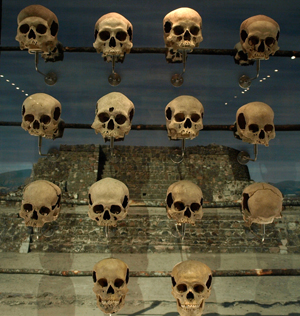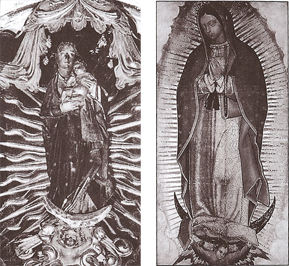Our Lady of Guadalupe: Ultimate Icon
We talked about Our Lady of Guadalupe, sharing some first-hand accounts of our recent visit to Mexico City for The World Meeting of Families, particularly with regard to the Tilma of Juan Diego which bears the image of Our Lady. We reviewed the extraordinary scientific aspects of the image, the profound and complex imagery and symbolism contained within it, the historical accounts of the appearance of the image and its effects, and its ongoing effects on people today.
Unlike the Shroud of Turin which could be referred to as a type of "photograph" of the Resurrection, the image of Our Lady of Guadalupe is more an icon, the most spectacular of all icons as it appears not to have been written by human hands.
The date: December 9, 1531; the place: what is now Mexico City, 10 years after the defeat of The Aztecs by Cortez. On Saturday, 12/9/1531, Juan Diego was on his way to his catechism when he heard music on the top of Tepeyac hill. He climbed to the top of the hill and saw Our Lady who spoke to him, sending him on a mission to Bishop Zumarrago, to ask him to build a chapel. The bishop was skeptical. Juan Diego returned to Our Lady and suggested she send one of the nobles, as he was of no importance (middle class). She told him to persist, and so the next day, Sunday, he saw the bishop again who told him to ask for a sign so that he might believe that she really was Our Lady. When Juan Diego returned home Sunday evening he found his uncle, Juan Bernadino, very ill. The following day, Monday, Juan Diego did not go to see Our Lady but stayed with his uncle. That night his uncle thought he was dying and so sent Juan Diego to get a priest to administer last rites. Tuesday morning Juan Diego left to get a priest, bypassing Tepeyac Hill in an effort to "dodge" Our Lady. The Virgin intercepted him and told him, "The thing that disturbs you is nothing. Am I not here, I who am your mother? Your uncle is healed" (Juan Diego would hear from his uncle later that he was in fact healed that morning after having a vision of Our Lady.) Our Lady then told Juan Diego to collect flowers on the top of Tepeyac Hill. She then arranges them in his tilma and tells him not to open the tilma until in the presence of the bishop. When Juan Diego opens his tilma before Bishop Zumarrago to show what he thought was the sign, flowers blooming out of season, the image of Our Lady of Guadalupe miraculously appears on his tilma. Within two weeks a chapel was built at the base of Tepeyac Hill. Juan Diego lived there the rest of his life, recounting the miraculous events to all who came. When he died in 1548, his friend Antonio Valeriano wrote what is the primary historical source regarding the events: The "Nican Mopohua," written a mere 17 years after they occurred.

While the conquest of The Aztecs in Mexico City ended the human sacrifices there, they still continued in outlying areas. After the miracle of Our Lady of Guadalupe, all human sacrifices stopped. There were mass conversions to Catholicism: 9 million in Mexico. This at a time when in Europe, Protestantism was leading to a loss of 5 million Catholics.
In addition to the miraculous origin of the image, scientific studies performed on the tilma have revealed a number of remarkable features. The media appears to be of 4 different types; there is no under drawing; the colors appear to be within the fibers of the tilma itself; the eyes have a 3-dimensional character to them when examined with an ophthalmoscope; and the most remarkable and indisputable feature is the existence of the tilma itself after almost 500 years. Experiments meant to discredit the image were carried out, placing a painted tilma in a frame and hanging it in the basilica. Within 7 years the experiment literally fell apart.
Why Guadalupe? This was the name Our Lady referred to herself as. It was a name well known by the Spanish Franciscans in Mexico. There was a famous statue of Our Lady, by tradition thought to have been carved by St. Luke and given to Spain by Gregory The Great in the 6th century. When the Muslims were invading Spain several centuries later, the statue was buried for protection in a small village called Guadalupe. After the Muslims were driven out of Spain, the statue was retrieved, became known as Our Lady of Guadalupe and was then kept at The Shrine of The immaculate Conception in Extremadura, Spain.
 What does that have to do with Mexico, or the image on the tilma? The statue in Spain bears little resemblance to the image. An icon is a visual representation of prayer, speaking to and of the mystical through symbolism. The image of a woman clothed with the sun, with the moon under her feet is described in Revelation. The symbolism traditionally refers to The immaculate Conception, which is the name of the shrine in Spain where the statue of Our Lady of Guadalupe is.In addition, there is a second statue at that shrine (shown to the left) placed there by the Franciscans about a century before the miracle in Mexico. This statue bears a striking resemblance to the image.
What does that have to do with Mexico, or the image on the tilma? The statue in Spain bears little resemblance to the image. An icon is a visual representation of prayer, speaking to and of the mystical through symbolism. The image of a woman clothed with the sun, with the moon under her feet is described in Revelation. The symbolism traditionally refers to The immaculate Conception, which is the name of the shrine in Spain where the statue of Our Lady of Guadalupe is.In addition, there is a second statue at that shrine (shown to the left) placed there by the Franciscans about a century before the miracle in Mexico. This statue bears a striking resemblance to the image.
In addition to the Christian symbols, there are many signs that would have been readily recognizable by the local population who did not have a written alphabet but used glyphs, or symbols in their writing. There are symbols referring to sacrifices, and to sacredness, heaven and royalty, as well as references to a traditional indigenous folk hero whose self sacrifice brought bones to life (a type of Christ). It is an icon of Christianity; of the sacredness of life; of prayer and evangelization. It was and continues to be an image which leads to profound conversions of the heart. As a young boy said to me on the bus to the Shrine, "When you see The Virgin, you'll see, you will be changed."
A Drop of Clear Water is a lay support group for Catholic teens. Our goal is to bring together teens who love their faith, are committed to chastity, and are ready to explore the wonder and beauty of Catholicism.

